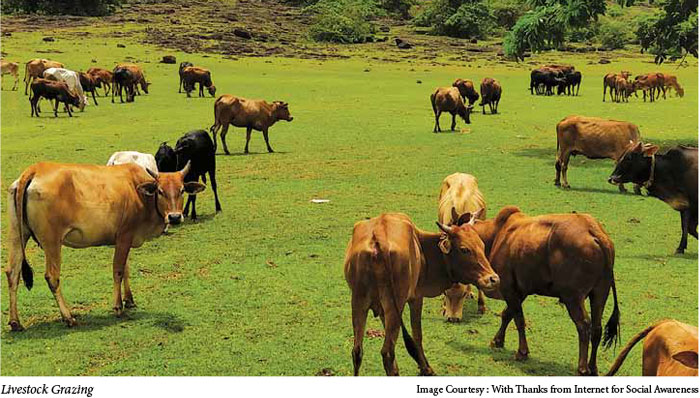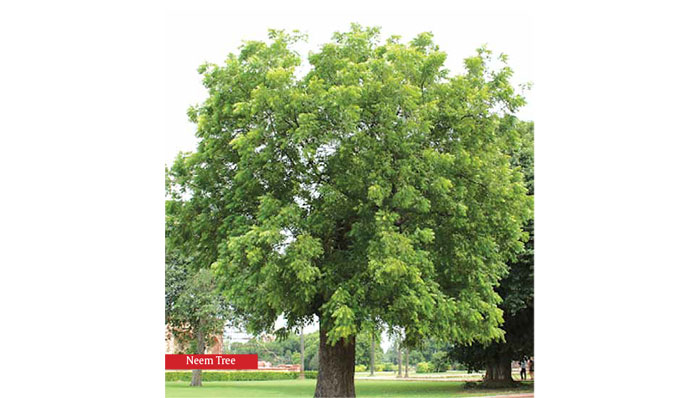
Azadirachta Indica (Neem): A Potential Tree Species for Dry Land Farming & Rural
Livelihood In India
By Pavithra G.M
Abstract : Azadirachta indica is a tree species native to the Indian subcontinent. It is a potential plant species suitable for a wide range of tropical, edapho-climatic factors. Habit, habitat, distribution, ethnobotany, economic status, state of scientific knowledge, seed collection and storage; handling, processing of seeds; propagation, regeneration, nursery technology, plantation and its management, pest and diseases; environmental and ecological aspects; utilization in medicinal purposes, traditional and modern value-added herbal products available in the market are dealt in this review..
Key words: Azadirachta indica, Dryland farming and rural livelihood
Introduction : Azadirachta indica can survive in a wide temperature ranges between minimum 0 to 15 °C to maximum 40 – 47.5 °C throught the year. Azadirachta indica is a tree of semi – arid tropics (dry areas) grows in areas receive rainfall of 450 mm to 1125 mm (Troup, 1921) and 60-90% relative humidity.
Azadirachta indca grows well on a wide variety of land use system which grows deep or shallow soil ranging (Sandy –
Rajasthan; Clayey – Maharashtra). It’s hard to expect survival in water logged, high saline or deep dry sand. Its best growth
is reported from black – cotton soils.
Top soil – 60 cm with soluble salts of 0.15%, pH 8.5 and Sub Soil 0.45% soluble salts, pH 9.8 Land suitability and topography may include plains and hilly region, elevation up to 1830 m.
Neem tree is usually sustaining green canopy except in very dry localities or in periods of extreme famine, they are leafless for a very short time so it’s a well-known “Shade tree”
Flowering followed by fruiting season depend on summer, rainy and winter season. Suppose January at Malabar February in Karnataka, March at Gujarat, M.H. & M.P., April in North India and Tamilnadu; May at Sub Himalayan region. Around 3 to 5 years from the time of germination, Neem matures and fruiting and its commonly found that it requires 10 to 12 years to expect its overall economic yield.
During this period a healthy neem tree can produce 37 – 55 kg seeds costs approximately 44.16 $ to 60.21 $ Neem has high tolerance to varied sunlight exposure. Generally, neem is a light demander tree. Water logged soil conditions may retard the growth also lead to high risk of mortality. Tap root system helpful to Stand in Drought, Tree coppices and root sucker in dry localities, but not in excessive rainfall.
Distribution : Globally Indo-Malesia; Indian distribution State – Kerala, District/s : All Districts

Propagation and Regeneration
Neem seedlings can be raised easily through direct sowing, planting out of entire plants or stump planting. Afforestation purpose, direct showing is successful. Raised to combination with field crop and gives the protection from animals. Late fruiting and less viability of seed – limitation
i) Nursery Technique : In Nursery beds, seeds may be sowed with the ideal spacing of 15 cm by 2.5 cm and the depth of 2.5 cm. Drip or sprinkler irrigation system to keep soil moisture shall be practised. The germination may start in about 8 days to three weeks. Seed beds – weeded – suppression of the seedling. Transplanting in 15 X 15 cm spacing or to poly-plast bag (5 cm
Height) – Seedling -50 cm to 120 cm.
ii) Azadirachta indica is seldom found growing gregariously.
Naturally from seeds also from coppice and root suckers. Fruit ripening in the rainy season – fallen fruit germinate within a fortnight (15 days) under the mature tree. The seedling establishes with tolerable freedom in depth for protection of thorny bushes. Once established; the seedling is hard to eradicate. Neem plantation involves proper management of planting quality material practicing Weeding and Hoeing on regular basis, Thinning for better growth and yield.

Azadirachta indica environmental and ecological aspects
Best shade tree for arid conditions such as Road side, canal bank, shelter belt along the railway track etc.,

Neem extracts may have toxic effects on fish and other aquatic wildlife and on some beneficial insects. Therefore, care should be taken while disposing left over extracts to water bodies. Any unused extracts are disposed by exposing them to heat or sunlight to break down the active compounds.
Extraction of biodiesel from Azadirachta indica:
Fossil fuels are fuels formed by natural resources such as anaerobic decomposition of buried dead organisms. Diesel which is a component in fossil fuel is a non-renewable resource because they take millions of years to form, and reserves are being depleted much faster than new ones are being made. The production and use of diesel raises environmental concerns. A global movement toward the generation of renewable energy is therefore under way to meet increased energy needs. Plant based oils have superior tri biological properties, and have wide spread use as additives to diesel. In order to use plant based oils into diesel, chemical modifications can be applied.
In this work chemical modification by using both acid and alkaline catalysts to convert (Azadirachta indica) neem seeds into Biodiesel is done. For this purpose, H2 SO4 and KOH catalysts are used. Batch process is adopted. The product has been analyzed and the results obtained are found to be coinciding. Other characteristics such as flash point, fire point, pour point, density, viscosity and calorific value of the product are also estimated. Since the demand for edible oils is more in our country the production of biodiesel using non edible oil feed stock i.e. (Azadirachta indica) neem seeds will be definitely more effective.
Azadirachta indica (Neem) is an evergreen tree, cultivated in various parts of subcontinent. Every part of the tree has been used as traditional medicine for household remedy against various ailments from antiquity. Neem has been extensively used as Ayurveda, Unani and Homeopathic medicine. The Neem Tree is an incredible plant that has been declared the Tree of the 21st century by the United Nations (Puri et. al., 1999). Extracts from the Neem tree are most consistently recommended in ancient medical texts for gastrointestinal upsets, diarrhoea and intestinal infections, skin ulcers and malaria (Schmuttereret. al., 1995). Its leave can be used as drug for diabetes, eczema and reduce fever. Barks of Neem can be used to make toothbrush and the roots has an ability to heal diseases and against insects. The seed of Neem tree has a high concentration of oil.
Neem oil is widely used as insecticides, lubricant, drugs for variety of diseases such as diabetes and tuberculosis (EL-Mahmood et. al., 2008 and Kumar et al. 2009). The Chemical constituents contain many biologically active compounds that can be extracted from neem, including alkaloids, flavonoids, triterpenoids, phenolic compounds, carotenoids, steroids and ketones. Azadirachtin is actually a mixture of seven isomeric compounds labeled as azadirachtin A-G and azadirachtin E is more effective(Verkerket al. 1993). Other compounds that have a biological activity are salannin, volatile oils, meliantriol and nimbin.
Drylands contribute 60 m tons of food grains to India’s food basket of 132 m tons. Almost all coarse grains and more than 90% of pulses and oilseeds are grown on these lands. In the case of cotton, about 74% of the acreage is rainfed.
The problems of drylands and its utilization:
In drylands with limited natural resources, efficient use must be made of the scarce resources of the land to meet the needs of the people for water, food, building materials and reasonable quality of life, and to maintain the functioning of natural systems on which all these depend. The nomadic lifestyle of many desert and dryland peoples made it possible to live off of limited resources over wide areas, and to seek out whatever was available in a highly variable environment, without over-using the land. Dust Storms in Sahara, are now so bad that the dust is carried to the Black Sea, to Europe or even across the Atlantic Ocean to the Caribbean. The dust blown from the plateaus of northern China now crosses the Pacific Ocean to North America.
Subjects covered include soil and climatic features of the region, crop production problems, production potential of different dryland crops, sequence cropping, fertilizer use, and others. The rural lifestyle in dryland which are much more numerous, more intricate and more varied compared to the problems of irrigated lands.
The propagation management in drylands by using simple tools and techniques were readily practiced by farmers and agriculturists. The risk of security threats would be efficiently taken care with the help of local community through proper communication. Water Scarcity due to irregular annual-rainfall pattern according to season. Human settlements nearby rare sources of water like rivers, springs, wells and oases. Implementation of innovative techniques adopted to capture and retain rainwater which includes rain water harvesting. Example in some coastal areas, trees or structures were used to condense moisture from the damp sea air. Now also many people struggling finding, conservating and transporting required amount of water for their daily life. In some drylands, agricultural areas are irrigated with water from dams or rivers, or pumped from underground aquifers. This is not always sustainable. As the water evaporates, it leaves salt behind, which may accumulate until the soil is so saline that nothing will grow there. It takes more water to flush the salt from the soil and carry it away. Also, many irrigated drylands depend on “fossil” groundwater left from earlier climate periods, or extract water from wells faster than it is recharged by rainfall. If the water level in the wells is dropping, and water must be pumped from deeper in the round, this is a sign of over-use. Pumping water from deep underground also requires lots of energy. Eventually there will be no more water, and such agriculture will collapse.
Prevention of Overgrazing which plays key role in dryland in checking soil erosion to improve the soil and trap moisture and make land productive and useful restoring vegetation can be the key to rehabilitating marginal lands.
Population growth is exponentially high so the waste management is looping unsolved. Land encroachment of more sedentary communities, and new technologies are modifying and limiting nomadic land uses and migrations. The systems are breaking down and the land suffers as a result. Human Habitat in rural environment involving housing and sanitation scarcity of water sources in villages and towns are particularly susceptible to pollution by animals and human wastes, unable to support themselves through a drought, they migrate to urban areas, resulting in overcrowding and make shift construction with consequent health problems.
The resulting vacuum allows anarchic development, resource abuse and destruction without the possibility of imposing modern systems of zoning or control in the common interest. Conflict between farmers and herders is frequent. While some land is abused, other areas are neglected. Restoring or building on customary systems of management may be the most acceptable and effective approach in drylands where this is still possible.
Solid waste management and land filling method one major problem in dryland areas linked to water shortages is the safe disposal of various wastes like domestic wastes, particularly human wastes and urban sewage. Improper and inadequate waste collection and treatment facilities, in spite of considerable efforts at rural sanitation, facilities in many rural areas are still rudimentary or entirely lacking. The result of which is serious health problems.
Radioactivity pollutants due to Uranium mines also occur in some dryland areas, and can contaminate land and water courses which is extremely unsafe for any biotic ecosystem.
Conclusions and Recommendations
Durable and termite resistant timber used to make temple idols. Twigs serve as ready-to-use toothbrushes in rural India. Wood, leaves and seeds have broad antibacterial and insecticidal properties. To encourage groundwater recharge and better land management practice there is a great scope to plant suitable species like neem. Neem is also a drought-tolerant plant that protects the soil from wind and rain,
- Agroforestry area of neem natural and plantation level census may be updated
- Financial Analysis of prominent agroforestry systems in various agroclimatic zones of India.
- Need to scale up the Neem cultivation in agroforestry to develop entrepreneurship and to improve ecological and economic strength of the rural community of the country.
- Neem must be promoted for afforestation in farm and social forestry plantations
- Innovative agroforestry for livelihood security in India.
Acknowledgment
The author is thankful to The Director of Institute of Wood Science & Technology (IWST), Bengaluru, one of the institutes of Indian Council of Forestry Research & Education (ICFRE). The authors are also thankful to Head of the Department, silviculture and forest management for encouraging and supporting throughout the preparation of the manuscript. The author is also thankful to Dr. N Ravi, Scientist – E for his guidance in editing the manuscript and his important suggestions for the paper.
References
Azadirachta indica A.Juss., Mem. Mus. Hist. Nat. Paris 19: 221. 1830; Gamble, Fl. Pres. Madras 177(127). 1915; Manilal & Sivar., Fl. Calicut 64. 1982; Mohanan, Fl. Quilon Dist. 111. 1984; Babu, Fl. Malappuram Dist. 116. 1990; Vajr., Fl. Palghat Dist. 113. 1990; M. Mohanan & Henry, Fl. Thiruvanthapuram 110. 1994; Sasidh., Fl. Shenduruny WLS 61. 1997; Sasidh. & Sivar., Fl. Pl. Thrissur For. 100. 1996; S.S. Jain & S.S.R. Bennet in Hajra et al., Fl. India 4: 478. 1997; Sasidh., Fl. Chinnar WLS 62. 1999; Sasidh., Fl. Parambikulam WLS 56. 2002; N.C. Nair & N.P. Balakr. in P. Daniel, Fl. Kerala 1: 648. 2005; Sunil & Sivadasan, Fl. Alappuzha Dist. 167. 2009; Ratheesh Narayanan, Fl. Stud. Wayanad Dist. 213. 2009.
DK Ved, Suma Tagadur Suresh chandra, Vijay Barve, Vijay Srinivas, Sathya Sangeetha, K. Ravikumar, Kartikeyan R., Vaibhav Kulkarni, Ajith S. Kumar, S.N. Venugopal, B. S. Somashekhar, M.V. Sumanth, Noorunissa Begum, Sugandhi Rani, Surekha K.V., and Nikhil Desale. 2016. (envis.frlht.org / frlhtenvis.nic.in). FRLHT’s ENVIS Centre on Medicinal Plants, Bengaluru. http://envis.frlht.org/ plant_details.php?disp_id=266
Flora of Kolhapur District, Yadav S. R & Sardesai M. M, 2002, Flora of Maharastra State Dicotyledones, Vol I, Lakshminarasimhan P. & Prasanna P. V, 2000 Melia azadirachta L., Sp. Pl. 385. 1753; Hook. f., Fl. Brit. India 1: 544. 1875.
Choudhary D.N., Singh J.N., Verma S.K., Singh B.P.. Antifertility effects of leaf extracts of some plants in male rats. Indian J Exp Biol 1990; 28: 714.
Corpinella M.C., Miranda M, Almiron W.R., Ferrayoli C.G., Almedia F.L., Palacios S.M. In vitro pediculicidal and ovicidal activity of an extract and oil from fruit of Melia azedarach L. J Am Acad Dermatol; 2007; 56:250-6.
Descalzo A.M., Coto C. Inhibition of the pseudo rabies virus by an and vital agent isolated from the leaves of Melia azedarach Rev. Argent Microbial; 1989; 21:133-40. 14) Sadasivam, S. and Balasubramanian, T. Practical Manual in Biochemistry. Tamil Nadu Agricultural University, Coimbatore, India, 1987; 14. 15) Awadh Ali, N.A.A., Jülich, W., Kusnick, C., Lindequist, U. Screening of Yemeni medicinal plants for antibacterial and cytotoxic activities. J.Ethnopharmacol. 2001; 74:173-179. 16) Chistokhodova, N., Nguyen, C., Calvino, T., Kachirskaia, I., Cunningham, G., Howard Miles, D. Antithrombin activity of medicinal plants from central Florida. J.Ethnopharmacol. 2002; 81:277-280. 17) Malick, C.P. and Singh, M.B.(1980) Plant Enzymology and Histo-enzymology 4th ed. Kalyani Publishers, New Delhi 18) Schander S.H. Method in food analysis. Academic Press, New York, 1970.
EL-Mahmood A.M., Doughari J.H., Ladan N. Antimicrobial screening of stem bark extracts of Vitellaria paradoxa against some enteric pathogenic microorganisms. Afr. J Pharm. Pharmacol. 2008; 2(5):089-094
Jacobson M. Review of neem research in the United States. In: Locke JC, Lawson, RH (eds) proceedings of a workshop in neems potential in pest management program. USDA-ARS. Beltsville, MD. ARS. 1990; 86:414. 11) Shoforowa A. (1993) Introduction to medical plants and traditional medicine spectrum book limited.
Jigna Parekh, and Sumitra Chanda, Antibacterial and phytochemical studies on twelve species of Indian medicinal plants. African Journal of Biomedical Research, 2007; 10:175 – 181 2) Mohammed Yusuf , Mai M Al-Oqail , Ebtesam S AlSheddr and M Atiqur Rahman, Diversity of Medicinal Plants in the Flora of Saudi Arabia 3: An inventory of 15 Plant Families and their onservation Management . International Journal of Environment, 2014; 3 (3):312-320
Kumar A, IIavarasan R, Jayachandran T, Decaraman M, Aravindhan P, Padmanabhan N, Krishman MR. Phytochemicals investigation on a tropical plant, Azadirachta indica Erode District, Tamil Nadu, South India. Pakistan Journal of Nutrition. 2009; 8(1):83-85.
Pichersky E. and Gang D.R. “Genetics and biochemistry of secondary metabolites in plants an evolutionary perspective” Trends in Plant Science, 2000; 5(10):439 – 445.
Puri H.S. Neem: The divine tree; Azadirachta indica. Amsterdam: Harwood Academic Publishers. 1999; 1-3.
Schmutterer H. The neem tree: Source of Unique Natural Products for Integrated Pest Management, Medicine, Industry
and Other Purposes, VCH, Weinheim, Germany. 1995; 1-696.
Verkerk R.H.J. and Wright D.J. Biological activity of neem seed kernel extract and synthetic azadirachtin against
larvae of Plutellaxylostellal. Pesticide Science. 1993; 37:83-91.
Wandscheer C.B. and Duque J.E. Larvicidal action of ethanolic extracts from fruits endocarps of Melia azedarach and Azadirachta indica against the dengue mosquito Aedes Aegypti. Toxicol 2004; 44: 829-35.
https://indiabiodiversity.org/biodiv/species/show/31068http://tropical.theferns.info/viewtropical.php id=Azadirachta+indica
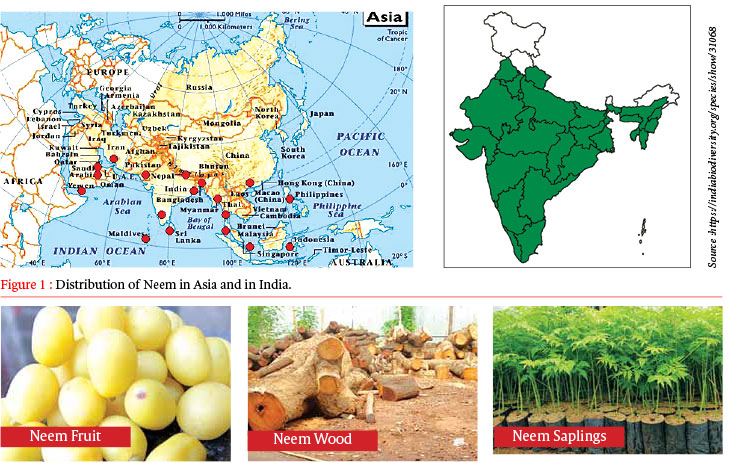
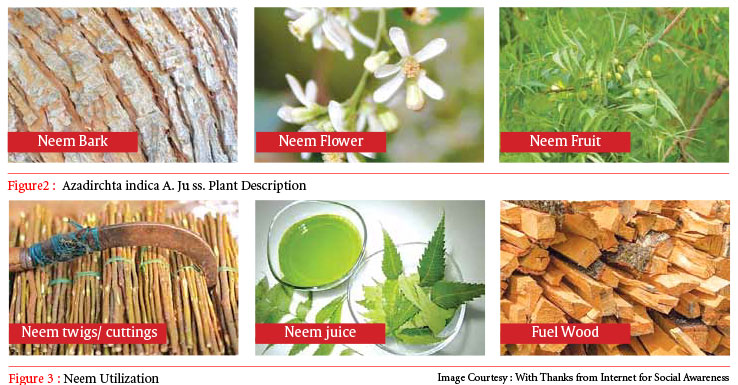
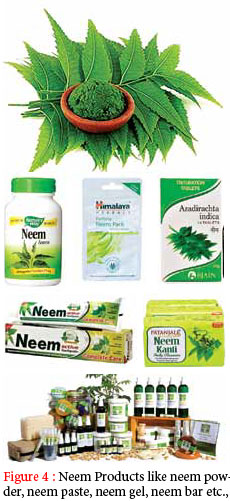
Author is a Guest Lecturer Subject Environmental studies in Government First Grade Degree College for Women, Chamarajanagar. Mysore University Aug 2014-June 2016 (2 Years), and Chikkamagalur, Kuvempu University Aug 2016 – June 2017 (1 Year)
Researcher 2017 till date at Institute of Wood Science and Technology, Bengaluru as JRF, on following projects.
- Soil carbon sequestration potential in permanent preservation plots in wet evergreen and moist deciduous forests in Central Western Ghats of Karnataka funded by Karnataka Forest Department. (2 Years).
- National program for conservation and development of Forest Genetics Resources (Project Component – E: FGR Conservation (Field gene bank)), funded by Indian Council of forestry Research and Education (ICFRE) Since March 2020 till date
Undergone many hands – on trainings, expertized observation and recording on-site activities, surveys and laboratory works, (soil carbon sequestration) at ICFRE-IWST and ICAR-NBSS&LUP.
Interests: Study of uptake-fate, and transport of selected micropollutants in edible plants Limited studies on profiling of emerging micropollutants waste-water and their uptake in edible plants in India.
Thrust Area
- Ensuring food safety.
- Soil Carbon sequestration and Climate Change.
- Bamboo propagation value addition and marketing.
- Study on plant Biomass and carbon content.
- Sandalwood- seed handling, nursery & plantation technology
- Conservation of biodiversity and Sustainable development.
- Development of new technologies to enhance environmental protection
and safety.
Key skills: Drafting research proposals, writing project research reports, using MS Office, Arc GIS, SPSS, Max Ent, R Statistical package



